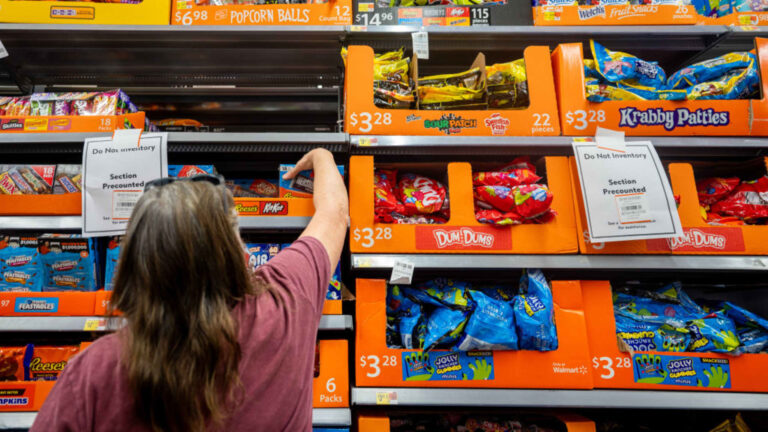A customer shops for Halloween candy at a Walmart Supercenter on October 16, 2024 in Austin, Texas.
Brandon Bell | Getty Images
The scariest thing haunting Halloween this year isn’t a ghost, goblin or ghoul — it’s the price of chocolate.
From Snickers to Reese’s to Twix, one of America’s favorite indulgences is getting more expensive, as tariffs, inflation and high cocoa prices squeeze profit margins and customers’ pocketbooks, possibly leading to fewer chocolate bars landing in trick-or-treat buckets this year.
Chocolate prices have surged nearly 30% since last Halloween and almost 78% in the past five years, according to data from research firm Circana and the U.S. Bureau of Labor Statistics. A 100-piece variety bag of candy now costs $16.39, up from $7.20 in 2020, FinanceBuzz found.
That spike is showing up on store shelves. Variety packs from Hershey — maker of Reese’s, KitKats and Heath bars — are up about 22%, while Mars, the company behind M&M’s and Milky Way, raised prices about 12%, according to the Century Foundation, a progressive, independent think tank, and the Groundwork Collaborative.
“The season did get off to a slow start,” Hershey CEO Kirk Tanner told investors on an earnings call Thursday, warning that holiday sales could be softer this year.
About 4 in 5 Americans buy candy for the Halloween holiday, according to YouGov. This time of year makes up about 18% of annual U.S. confectionery sales — second only to Christmas, according to the National Confectioners Association.
But chocolate’s dominance is slipping. Circana found it made up 52% of Halloween candy sales last year, compared with 44% this year, as shoppers shift toward cheaper, trendier sweets.
“Macroeconomic headwinds” are among the culprits, said Sally Wyatt, who works for Circana analyzing global consumer packaged goods and as a food-service industry advisor. “It’s the compounded impact on top of the fact that we’ve outpaced wage growth. So consumers have started to … [make] very specific choices on discretionary items.”
Sector-wide, candy prices are outpacing the national inflation rate, marking a roughly 10% increase compared with last year, according to the Century Foundation. Still, the National Retail Federation said 2025 is expected to be a record year for candy sales in the U.S., with about $3.9 billion spent on Halloween candy alone.
“Even as consumers face higher prices for food, they continue to leave room in their budgets for chocolate and candy, meaning that the category is strong, vibrant and growing,” Carly Schildhaus, a spokesperson for the National Confectioners Association, told CNBC.
Much of the chocolate filling U.S. shelves this fall was made from cocoa beans purchased at record prices last December, when futures peaked above $12,000 per ton, experts said. Prices have since cooled to around $6,000, but that’s still more than double the pre-pandemic average.
A cocktail of rising temperatures, erratic rainfall, drought and crop disease for the past three years has devastated harvests in West Africa, which produces roughly 70% of the world’s cocoa. The result: the largest global cocoa deficit in 60 years, with supply falling half a million tons short of demand.
Prices could stabilize, but not decrease, by next year as crop yields have increased, said David Branch, a sector manager at Wells Fargo Agri-Food Institute.
“It’s not just the cost of manufacturing cocoa and other ingredients,” Branch told CNBC. “It’s also a combination of labor, transportation, fuel, overhead [and] all of those factors, and, given the inflationary rate we’ve been in, those came up and haven’t really come down.”
Hershey said Thursday that tariff expenses will cost the company $160 million to $170 million this year. In July, it also announced a “low double-digit” price hike, though executives said those increases weren’t tied to tariffs or Halloween pricing.
Chocolate makers have lobbied the Trump administration for tariff exemptions on cocoa and other agricultural imports, arguing they have little ability to source those ingredients domestically.
Sweet variety
As chocolate becomes more expensive, fruity, sour and chewy candies have gotten more popular. More than half of shoppers said they planned to prioritize gummy candies for Halloween this year, NielsenIQ found.
On average, the price per pound of chocolate rose nearly 14% in the 12 weeks ending Oct. 5, while sales volumes fell 6%, Circana data show. Non-chocolate Halloween candy such as Jolly Ranchers and Skittles saw sales climb 8.3% in that same period.
Younger adults, especially Gen Z, are also fueling growth in non-chocolate categories — gravitating toward gummies, freeze-dried sweets and TikTok-friendly flavor mashups.
“It’s that experiential [aspect] because you can have it [non-chocolate items] with chewy, with sweet flavors, with hot and sweet, spicy flavors,” Wyatt told CNBC. “Some candies you get this big explosion in your mouth of flavors. We’ve seen it popular with different cohorts.”
Chocolate makers are responding in kind. Hershey has expanded its gummy lineup, including a partnership with Shaquille O’Neal, and rolled out ghost-shaped Twizzlers and mismatched “Trickies” Jolly Rancher gummies.
Mondelez International, maker of Cadbury and Toblerone, said it’s also prioritizing gummies in the U.S. market. CEO Dirk Van de Put said on an earnings call Tuesday, however, that the U.S. market in particular “is slower than we’ve seen in quite a while” and the company’s promotional strategy earlier this year “was not giving us the volume effect that we were hoping for.”
Manufacturers are also experimenting with smaller bars, new fillings and cocoa-free options such as crème or nut-based confections to offset rising ingredient costs, Branch said.
“Companies have got to be very aware of if they can keep their prices in line. They can’t just keep increasing their prices and expect sales to continue to go up,” Branch said. “But customers have not lost their appetite for chocolate. It’s going to remain an indulgence that people will always have and can’t really do without.”

